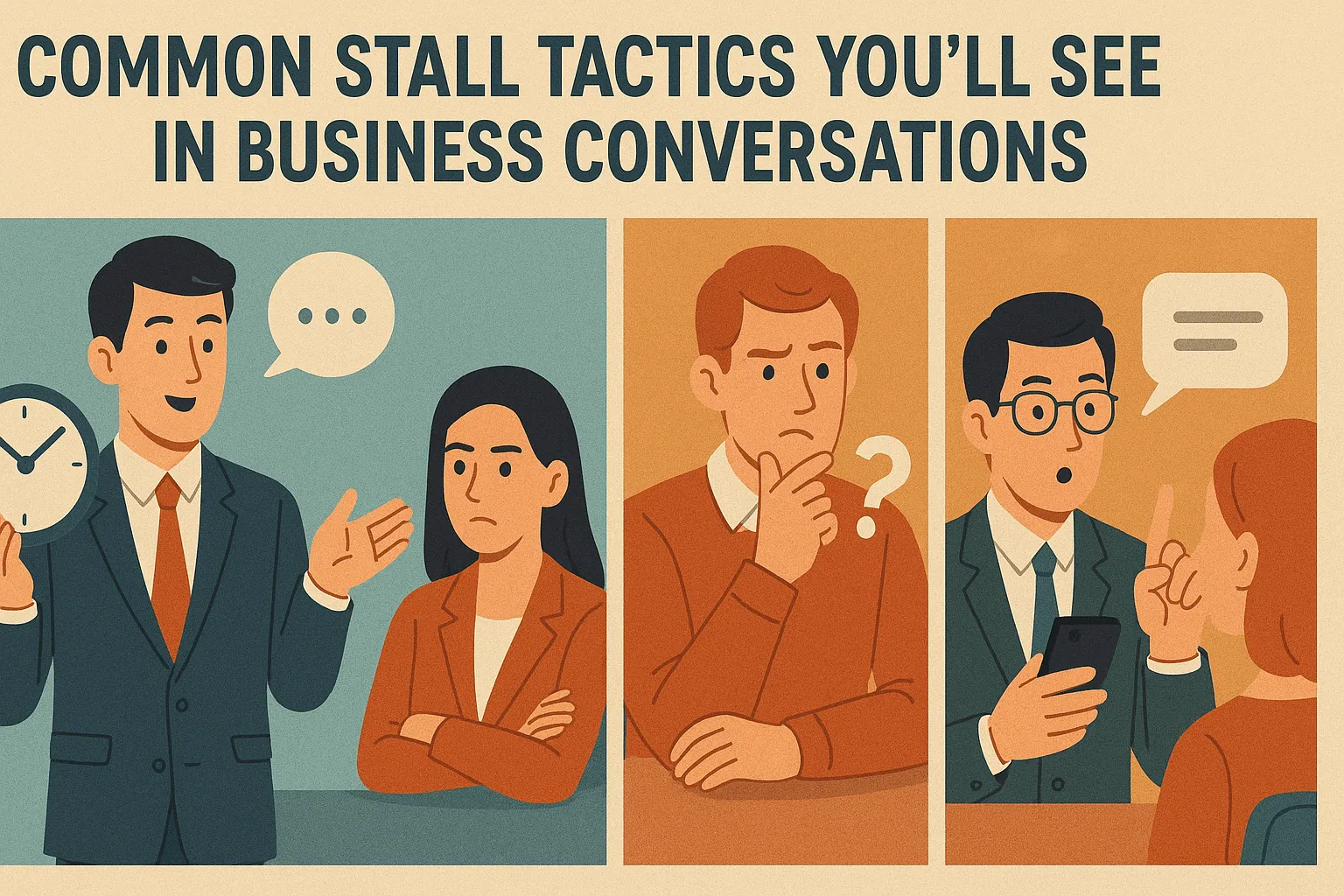Did you know that 60% of sales opportunities stall somewhere in the process because people just don’t make a decision? (Source: HubSpot 2024).
If you’ve ever sat through three “let’s circle back” meetings or heard “I just need more time,” you know exactly what that feels like.
Imagine being stuck in a stalled negotiation, watching the momentum fade as each new delay drags the process out even further. A stall tactic can turn a great deal into a never-ending waiting game.
In this guide, you’ll learn why it happens, the most common delay tactics, and how you can respond without losing confidence. You’ll also see how to restart stalled negotiations and finally get your deals across the finish line.
What Is a Stall Tactic and Why Does It Show Up in Negotiations or Sales?

A stall tactic is when the other party slows down a decision on purpose, often requiring more effort to get back on track. A stalling tactic is sometimes used as a strategic method in negotiations to control the pace and influence the outcome. It can happen in sales, a business meeting, or during negotiations.
People use it when they feel unsure, want control, or need more time in the buying process. Research by HubSpot shows 60% of deals stall before approval. A stalling tactic can sometimes provide a benefit, such as giving both parties more time to gather information or reconsider terms.
You might hear “let me check with my team” or “maybe next quarter.” Leaders also use it to protect money or get an upper hand. When you see these signs, ask clear questions so the deal moves forward.
Common Stall Tactics You’ll See in Business Conversations

- “I need more time to think” – The other party uses this delay tactic when they are unsure or trying to slow the buying process without saying no.
- Endless meetings without progress – Extra meetings can be a polite way to avoid making a major buying decision.
- “I’ll need to check with my team” – Shifting the decision to other parties creates more steps and delays.
- Sudden silence or no response – A classic stall tactic where prospects or customers stop replying to emails and calls. Some prospects even get cold feet at the last minute and stop replying altogether.
- Raising an objection – The prospect brings up an objection, such as a concern or hesitation, as a way to delay the decision-making process. Recognizing and addressing these objections is key to moving the conversation forward.
- Introducing new conditions late in the process – The other party may add extra requirements just before the finish line to slow things down.
- Budget or approval excuse – Claims about waiting for budget approval or needing upper-level sign‑off to buy more time.
- Focusing on small details – Talking only about minor points instead of discussing the main deal can be a way to avoid a decision.
- “We’ll decide after the next quarter” – Pushing the timeline forward to avoid committing right now.
Management Stall Tactics: Why Leaders Sometimes Delay Decisions
A management stall tactic happens when leaders slow a decision on purpose. It is common in sales, negotiations, and the buying process.
Why does this happen? Often the other party wants more control or hopes to avoid risk. Harvard Business Review notes that big companies take 20% longer to approve a deal because of extra steps.
How to avoid it:
- Ask, “What information do you need to move forward?”
- Confirm timelines in writing after each meeting.
- Share how delays can cost money or slow success.
- Keep leaders involved early so the process does not stop at the finish line.
When you see these stall tactics, stay calm. Clear questions and simple next steps will help you close the deal faster. You can expect better results when you ask clear questions and confirm timelines early
How a Stall Tactic Can Derail Negotiations and Sales

A stall tactic can stop progress fast. It slows the buying process, adds extra meetings, and makes the other party lose focus. If not managed properly, a stalled process can cause a sale to be lost entirely. Studies show that 60% of deals never reach the finish line because of delays (HubSpot, 2024).
When a stall tactic appears:
- The conversation goes in circles.
- Leaders wait for more approval instead of acting.
- Prospects lose interest and move to another company.
- Time and money are wasted while the deal is on hold.
To protect your sales and negotiations, watch for these early signs. Ask clear questions, confirm the next step, and keep the process moving. If a stall tactic slows you down, change course by setting smaller steps and fresh goals.
Effective Ways to Respond to a Stall Tactic Without Losing Confidence

- Acknowledge the pause, then redirect: If the other party asks for more time, say, “I understand. Let’s set a clear next step so we keep things moving.”
- Ask open but firm questions: Use questions like, “What’s the main concern holding up this decision?” to turn silence into a clear answer.
- Put timelines in writing: Summarize decisions and deadlines after each meeting. It creates gentle pressure without sounding pushy.
- Show the cost of delay: Explain how waiting impacts money, time, or opportunity so they see what they stand to lose.
- Keep the focus on the outcome: Instead of chasing excuses, bring the conversation back to how the deal benefits their team or company.
- Break the decision into smaller steps: If a major buying decision feels overwhelming, suggest an easy first step to build confidence.
- Stay calm and professional: Confidence makes you look in control of the process, even when delays happen.
- Use the stall to negotiate: Take advantage of the pause to negotiate more favorable terms or clarify expectations. Strategic patience and leveraging the delay can help you influence the outcome.
In some cases, a quick compromise on small points can help the team move forward instead of staying stuck.
Handling the Buying Process: When the Other Party Delays Approval

A stall tactic often appears during the buying process when the other party delays approval. This is common in big organizations where leaders need sign‑off from several parties.
Understanding the structure of the organization and identifying key stakeholders early in the process is crucial to ensure smoother negotiations and avoid unnecessary delays.
Gartner research shows that B2B deals now involve an average of 11 decision‑makers. Many leaders are familiar with these delays and know how a slow process can hurt a company
What you should do:
- Confirm the steps early: Ask, “Who needs to approve this deal?”
- Keep all parties in the loop: Share updates with the team so no one is left out.
- Put dates in writing: After every meeting, write the next step and timeline.
- Show the cost of waiting: Explain how delays can hurt the company’s success and waste money.
Clear steps reduce confusion and help you move forward when a stall tactic slows approval.
How to Restart Stalled Negotiations Before the Deal Slips Away

- Reconnect with value: Remind the other party why the deal matters—highlight outcomes they care about, not just the terms.
- Address hidden concerns: Ask directly, “What’s stopping us from moving forward?” to surface any unspoken objections.
- Bring all parties back to the table: Schedule a clear meeting with decision-makers so the discussion gains focus again.
- Revisit topics previously discussed: Go over earlier points that were discussed to see if new solutions or compromises can be found.
- Simplify the next step: If the process feels heavy, suggest a smaller milestone (like a pilot, trial, or partial agreement).
- Use new information: Share a recent result, case study, or market insight that gives the conversation fresh energy.
- Introduce the idea of brainstorming alternatives: Suggest the idea of working together to brainstorm alternative approaches or solutions that could move the negotiation forward.
- Reset the timeline: Agree on a revised deadline so everyone knows when decisions need to happen.
- Stay visible without pressure: Keep in touch with useful insights instead of silence so the other party doesn’t forget your value.
Sometimes a stalled negotiation needs a fresh settlement plan to reach an agreement quickly.
Smart Sales Strategies That Create Momentum and Close Deals Faster

Implementing these smart sales strategies leads to more successful negotiations and faster deal closures by guiding the process toward positive outcomes.
1. Lead with value, not features
Many people lose interest when they hear long lists of features. Focus on what the service or product does for the customer. Example: instead of saying, “This software has 20 tools,” say, “This software will save your team 10 hours a week.”
How to implement it:
- Ask the other party about their main concerns.
- Show how your offer fixes those concerns.
- Use simple stories from other customers as proof.
- Share success stories about your services to build credibility and trust.
2. Shorten the buying process
The more steps in a process, the more likely a stall tactic will slow it down. Gartner research shows that a long approval process is one of the biggest reasons for lost deals.
How to implement it:
- Break a big contract into smaller steps.
- Offer a pilot program or short trial.
- Make sure all parties know who approves the agreement.
Most companies cannot afford to wait months when a potential deal is ready to close.
3. Create urgency without pressure
People move faster when they see a clear reason to act. Pressure can push them away, but urgency helps them make a major buying decision.
How to implement it:
- Show the cost of waiting: time, money, or lost chances.
- Share new data or examples that support fast action.
- Make the point that acting quickly can be the difference between winning and losing a deal.
- End each meeting with a next step and timeline.
A clear plan gives everyone a sense of direction and keeps the process under control.
4. Always confirm the next step
A simple mistake in sales is leaving a meeting without a clear next action. This gives the other party space to slow down or use a delay tactic.
How to implement it:
- Before you end a call or meeting, ask, “What happens next?”
- Write down who is responsible for each step. Always keep a clear account of who is responsible for each step so that there is no confusion.
- Send a short follow‑up email with dates so everyone knows the timeline.
When you confirm the next step, you make it harder for the process to stall.
5. Build relationships, not just deals
People prefer to work with someone they trust. When there is no relationship, a customer can easily walk away or delay. According to Salesforce, 79% of business buyers say a trusted advisor matters more than price.
How to implement it:
- Take time to understand the person and their concerns.
- Check in between meetings with helpful insights.
- Show interest in their goals, not just in closing the contract.
Good relationships make it harder for a stall tactic to succeed.
6. Use clear and simple proposals
Confusing proposals cause delays. If a contract is full of long terms, the other party will need more meetings and approvals.
How to implement it:
- Write in plain English.
- Highlight only the key points that matter to their team.
- Make the agreement easy to read so leaders can approve it quickly.
A simple proposal builds confidence and keeps the deal moving forward.
7. Involve the right people early
Even office politics can slow a buying decision if the right people are not involved early. Many deals slow down because the right people are not in the room. If leaders or decision-makers join late, you face more approval steps, delays, and even a stall tactic from the other party.
How to implement it:
- Ask in the first meeting, “Who must approve this deal?”
- Invite those people to early meetings.
- Share clear notes so everyone stays on the same page.
This keeps control of the process and stops long back-and-forth discussions that cause lost time and money.
8. Stay proactive
A stall tactic works best when you stay silent. You can avoid this by taking action before problems appear.
How to implement it:
- Follow up quickly after every meeting.
- Send new data, examples, or success stories that answer common concerns.
- Track the next step so the deal does not stop at the finish line.
Proactive sales reps reduce excuses, build confidence, and move stalled negotiations forward. Teams that act early and avoid delay tactics gain a clear advantage over slow-moving competitors.
Conclusion
A stall tactic can slow any business deal. You now know how to spot delays, involve the right people, and keep prospects talking. Stay proactive, use a clear strategy, and discuss next steps early. When you lead with value, you can handle tough negotiating without losing time or money and move every potential deal forward with confidence.





.webp)

.jpg)
